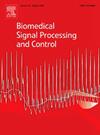DBMAE-Net: A dual branch multi-scale feature adaptive extraction network for retinal arteriovenous vessel segmentation
IF 4.9
2区 医学
Q1 ENGINEERING, BIOMEDICAL
引用次数: 0
Abstract
Vessel morphology and tube diameter changes in the retina are closely related to diseases such as diabetic retinopathy and glaucoma. Traditional methods of vessel segmentation and tube diameter measurement suffer from insufficient accuracy and low automation. To address these limitations, this paper proposes a retinal arteriovenous segmentation network model based on dual branch multi-scale feature adaptive extraction. The model is designed to tackle the challenge of complex and similar arteriovenous vessel structures by incorporating a multi-scale feature extraction and fusion module, which enhances the capture of contextual vessel information and microvascular features. To ensure the model learns rich semantic information, a dual-branch encoder is implemented to extract multi-scale and residual features. The multi-feature local global attention fusion module then performs feature fusion, integrating these features effectively. In the down-sampling module, an adaptive pooling mechanism is introduced to balance detailed and global information of the arterial vessels. This adaptive learning of hyperparameters helps to mitigate the confusion between arterial and venous vessels. Furthermore, a multi-layer semantic supervision module is incorporated to enhance the model’s learning ability and improve segmentation accuracy for arteriovenous vessel features. The method’s effectiveness is validated on the DRIVE-AV, HRF-AV, and LES-AV datasets, achieving accuracy rates of 94.19%, 99.26%, and 93.10%, respectively. Additionally, an equivalent diameter measurement method based on optic disc and macular localization is proposed. This method accurately calculates the equivalent diameter of arterioles and veins, providing quantitative indices for the auxiliary diagnosis of related diseases and enhancing clinical efficiency.

求助全文
约1分钟内获得全文
求助全文
来源期刊

Biomedical Signal Processing and Control
工程技术-工程:生物医学
CiteScore
9.80
自引率
13.70%
发文量
822
审稿时长
4 months
期刊介绍:
Biomedical Signal Processing and Control aims to provide a cross-disciplinary international forum for the interchange of information on research in the measurement and analysis of signals and images in clinical medicine and the biological sciences. Emphasis is placed on contributions dealing with the practical, applications-led research on the use of methods and devices in clinical diagnosis, patient monitoring and management.
Biomedical Signal Processing and Control reflects the main areas in which these methods are being used and developed at the interface of both engineering and clinical science. The scope of the journal is defined to include relevant review papers, technical notes, short communications and letters. Tutorial papers and special issues will also be published.
 求助内容:
求助内容: 应助结果提醒方式:
应助结果提醒方式:


